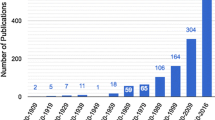Abstract
This article maps the state of political science since the turn of the millennium. It begins by reviewing the influential description of the discipline in Robert Goodin’s (2011 [2009]) introduction to the Oxford Handbook of Political Science. It then introduces an alternative approach, based on citation indexes, to generate a comparative list of influential authors for the same time period. After comparing Goodin’s list with our own, we use the same method to generate a list of the most influential books and articles of the 2009–2018 period and describe how the discipline has changed over the intervening decade. Two of the more interesting findings include the continued importance of books (in addition to articles) in political science citations and an apparent trend towards increased pluralism in recent years.
Similar content being viewed by others
Notes
In particular, in 2009, Goodin counts index entries to authors included in the Handbook, while the earlier version counted the frequency of an author’s inclusion in the reference lists.
The process was straightforward. We first generated a list of the top 15 journals in each of the three fields (PS/IR, PA, SOC/PS), as ranked by the SJR index. We then combined the three lists and re-ranked them using their SJR score. At this point, we jettisoned duplicate journal listings and those journals that were explicitly linked to tangential disciplines (e.g. American Sociological Review or the Journal of Personality and Social Psychology). Field-neutral journals (e.g. Structural Equation Modeling) and open-access journals (e.g. Living Reviews in European Governance) were included in the lists (the latter were more relevant in the second period under study).
It might be noted that the “limited” number of citations is a function of the “local” search—a piece like Fearon and Laitin’s will produce a much larger number of citations in more open searches For example, it receives 8827 citations in Google Scholar (and a more modest, but still extremely high, 2850 in the Web of Science itself).
We did a little digging. According to WoS, the Berinsky article is cited in a wide array of disciplines, including political science, psychology, communications and business. Iacus’s article is cited by political scientists, as well as those in management, economics, business and occupational health. Carter’s piece lands in PS/IR journals, but also in economics, sociology and public administration, While Grimmer’s audience includes political scientists, as well as experts in communication, computer science, law and sociology. Vermunt is perhaps most unique, in that most of the references are from outside mainstream political science, including psychiatry, psychology, public health and substance abuse.
Specifically, the data file from WoS includes a separate line (tagged C1) with the author affiliation, which is standardized to always end with the country of the affiliated university. Each author gets his/her own line, all ending in the country.
References
Aria, M., and C. Cuccurullo. 2017. Bibliometrix: An R-tool for comprehensive science mapping analysis. Journal of Informetrics 11 (4): 959–975.
Beck, N., J.N. Katz, and R. Tucker. 1998. Taking time seriously: Time-series-cross-section analysis with a binary dependent variable. American Journal of Political Science 42 (4): 1260–1288.
Berinsky, A.J., G.A. Huber, and G.S. Lenz. 2012. Evaluating online labor markets for experimental research: Amazon. com’s mechanical turk. Political Analysis 20 (3): 351–368.
Carter, D.B., and C.S. Signorino. 2010. Back to the future: Modeling time dependence in binary data. Political Analysis 18 (3): 271–292.
Collier, P., and A. Hoeffler. 2004. Greed and grievance in civil war. Oxford Economic Papers 56 (4): 563–595.
Fearon, J.D., and D.D. Laitin. 2003. Ethnicity, insurgency, and civil war. American Political Science Review 97 (1): 75–90.
Giles, M., and J. Garand. 2007. Ranking political science journals: Reputational and citational approaches. Political Science and Politics 40(4): 741–751.
Gleditsch, N.P., P. Wallensteen, M. Eriksson, M. Sollenberg, and H. Strand. 2002. Armed conflict 1946–2001: A new dataset. Journal of Peace Research 39 (5): 615–637.
Goodin, R.E. 2011 [2009]. The state of the discipline, the discipline of the state. In The Oxford handbook of political science, ed. R.E. Goodin, 3–57. Oxford: Oxford University Press.
Goodin, R.E., and H.D. Klingemann (eds.). 1996. A new handbook of political science. Oxford: Oxford University Press.
Monroe, K.R. (ed.). 2005. Perestroika! The Raucous Rebellion in Political Science. New Haven: Yale University Press.
Rothstein, B. 2005. Is political science producing technically competent barbarians? European Political Science 4(1): 3–13.
Royal Society. 2020. The Journal Metrics. Available at https://royalsocietypublishing.org/rsif/citation-metrics#question2. Accessed 20 April 2020.
Scimago Research Group. 2007. Description of Scimago Journal Rank Indicator. Available at https://www.scimagojr.com/SCImagoJournalRank.pdf. Accessed 11 April 2020.
Acknowledgements
The authors would like to thank Michael Alvarez and the EPS editors for their useful comments and suggestions. Obviously, any remaining errors and opinions are those of the authors. Certain data included herein are derived from Clarivate Web of Science. © Copyright Clarivate 2020. All rights reserved.
Author information
Authors and Affiliations
Corresponding author
Additional information
Publisher's Note
Springer Nature remains neutral with regard to jurisdictional claims in published maps and institutional affiliations.
Rights and permissions
About this article
Cite this article
Jensen, M.R., Moses, J.W. The state of political science, 2020. Eur Polit Sci 20, 14–33 (2021). https://doi.org/10.1057/s41304-020-00297-4
Accepted:
Published:
Issue Date:
DOI: https://doi.org/10.1057/s41304-020-00297-4




